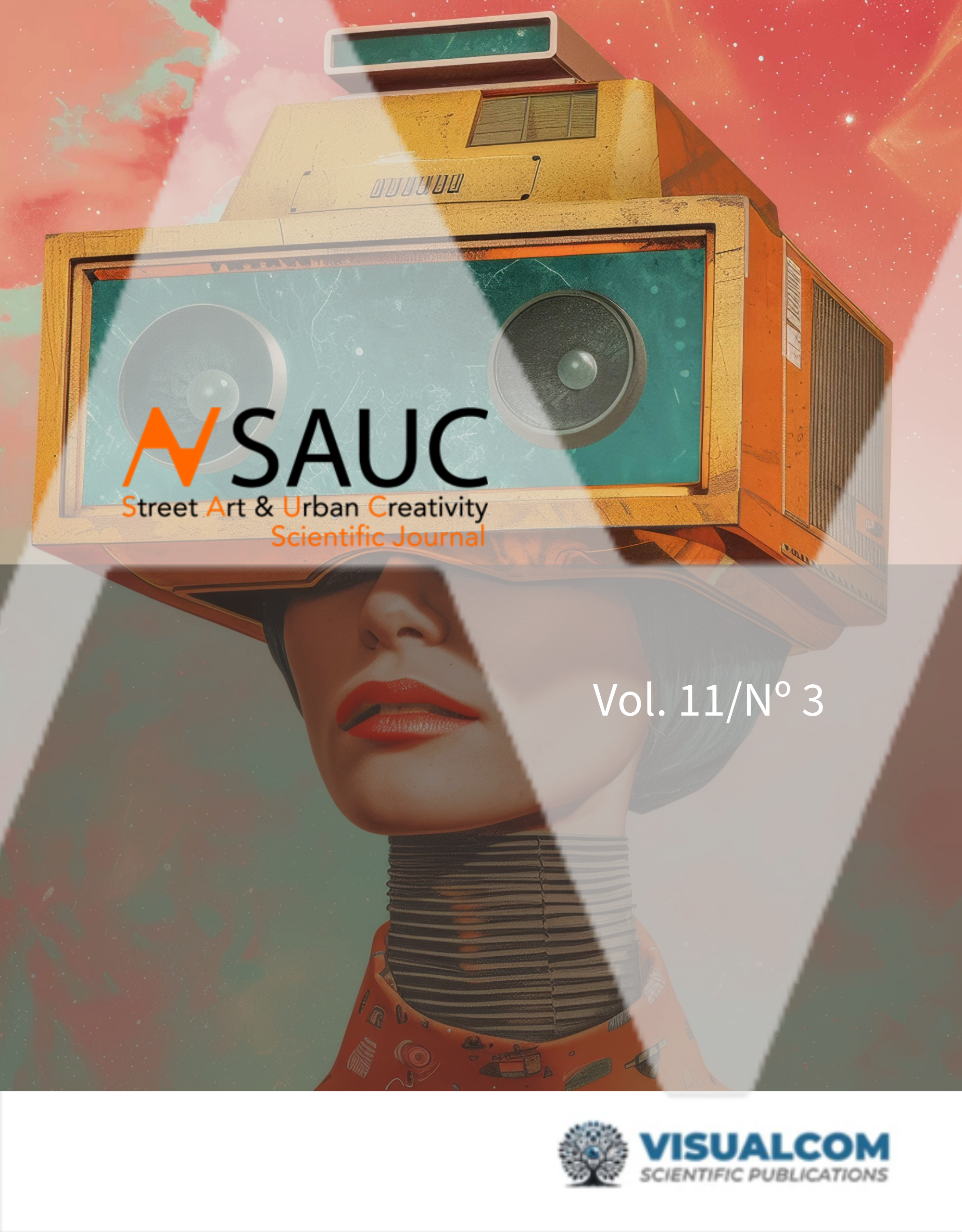Graphic design and creativity in urban identity
The legacy of Nacho Padilla's posters to the city of Madrid
DOI:
https://doi.org/10.62161/sauc.v11.5710Keywords:
Nacho Padilla, Madrid, Poster, Graphic Design, Advertising creativity, City branding, Urban identityAbstract
This article aims to analyse Nacho Padilla's work as creative director of Madrid City Council during Manuela Carmena's term of office. This post, created during that legislature, had the objective of centralising all the creative projects, planning and supervising them in order to project a coherent visual and graphic narrative that would reinforce the capital's brand image.
Padilla's work, a leading figure in the vibrant Spanish graphic design scene today, has left a very significant mark on the city of Madrid, especially through his contribution to the poster design of memorable campaigns such as those for San Isidro 2018 and 8M 2019. At a time when cities need to regain confidence and captivate both residents and visitors, public image and institutional campaigns play a decisive role in the strategy to revitalise urban life.
Downloads
Global Statistics ℹ️
|
393
Views
|
336
Downloads
|
|
729
Total
|
|
References
Balaguer, E. (2020, 20 de febrero). El Ayuntamiento de Madrid abraza el legado del director de arte de Carmena (y sus campañas ilustradas). El País. https://elpais.com/elpais/2020/02/20/icon_design/1582188355_808093.html
Bon, M. (2018, 27 de marzo). ¿Qué es el Acuerdo Marco de Creatividad y Diseño Gráfico y qué novedades trae la segunda convocatoria? Gràffica. https://graffica.info/que-es-el-acuerdo-marco-de-creatividad-y-diseno-grafico/
Coronado e Hijón, D. (2002). La metáfora del espejo: teoría e historia del cartel publicitario. Ediciones Alfar.
Canosa, E., & García, A. (2012). La construcción de la marca Madrid. Cuadernos Geográficos, 51(2), 195-221. http://hdl.handle.net/10486/665624
Checa, A. (2014). El cartel, dos siglos de publicidad y propaganda. Advook
Costa, J. (2004). La imagen de marca. Paidós.
De San Eugenio, J. (2011). Teoria i mètodes per a marques de territoris. Editorial UOC.
De San Eugenio, J., Nogué, J., & Govers, R. (2017). Visual landscape as a key element of place branding. Journal of Place Management and Development, 10(1),23-44. https://doi.org/10.1108/JPMD-09-2016-0060 DOI: https://doi.org/10.1108/JPMD-09-2016-0060
Dondis, D. A. (2017). La sintaxis de la imagen. Gustavo Gili.
Enel, F. (1974). El cartel. Lenguaje, funciones y retórica. Fernando Torres Editor.
Galdón, G. (2002). Teoría y práctica de la documentación informativa. Ariel.
González-Díez, L., Tabuenca, M. & Bartolomé, A. (2019). La imagen de la revolución rusa a través de los carteles de la ROSTA. ASRI. Arte y Sociedad. Revista de Investigación, (16), 37-50.
Govers, R. & Go, F. (2009). Place Branding: Glocal, Virtual and Physical Identities, Constructed, Imagined and Experienced. Palgrave Macmillan. DOI: https://doi.org/10.1007/978-0-230-24702-4
Gubern, R. (1987). La mirada opulenta. Exploración de la iconosfera, Gustavo Gili.
Kavaratzis, M. (2004). From city marketing to city branding: towards a theoretical framework for developing city brands. Journal of Place Branding and Public Diplomacy, 1(1), 58-73. https://doi.org/10.1057/palgrave.pb.5990005 DOI: https://doi.org/10.1057/palgrave.pb.5990005
Kunz, W. (2000). Typography: Macro+Micro Aesthetics. Niggli Publishers.
Llorente, S. (2019, 19 de junio). Quédate en Madrid: las (maravillosas) campañas creativas bajo la batuta de Nacho Padilla. Gràffica. https://graffica.info/nacho-padilla-ayuntamiento-madrid-carteleria/
Lupton, E. (2024). Pensar con tipos. Gustavo Gili.
Marzi, G., Balzano, M., & Marchiori, D. (2024). K-Alpha Calculator—Krippendorff's Alpha Calculator: A User-Friendly Tool for Computing Krippendorff's Alpha Inter-Rater Reliability Coefficient. MethodsX, (12), 102545. https://doi.org/10.1016/j.mex.2023.102545 DOI: https://doi.org/10.1016/j.mex.2023.102545
Meggs, P. (1998). A History of Graphic Design. John Wiley & Sons.
Melendreras, E. (1985). 100 años de cartel español. Cámara de Comercio e Industria.
Moles, A. (1976). El affiche en la sociedad urbana. Paidós.
Munari, B. (2019). Design as Art. Penguin Classics.
Nicoletti, P. (2003). Introducción a la sociología. Ediciones Mediarte Estudios.
Oliveira, E. (2015). Place branding as a strategic spatial planning instrument. Journal of Place Branding and Public Diplomacy, 11(1), 18-33. https://doi.org/10.1057/pb.2014.12 DOI: https://doi.org/10.1057/pb.2014.12
Peel, D. & Lloyd, G. (2008). New communicative challenges: Dundee, place branding and the reconstruction of a city image. Town Planning Review, 79(5), 507-532. http://www.jstor.org/stable/40112780 DOI: https://doi.org/10.3828/tpr.79.5.4
Rainisto, S. (2007). Success factors of place branding. Regions Magazine, 268(1), 20-22. https://doi.org/10.1080/13673882.2007.8628829 DOI: https://doi.org/10.1080/13673882.2007.8628829
Rams, D. (2011). As little design as possible. Phaidon.
Tabuenca, M., González-Díez L. & Puebla, B. (2020). Propuesta metodológica para el análisis gráfico, tipográfico y cromático de cartelería. Pensar la Publicidad. Revista Internacional de Investigaciones Publicitarias, 14(2), 269-280. https://doi.org/10.5209/pepu.72134z DOI: https://doi.org/10.5209/pepu.72134
Tabuenca, M., González-Díez, L., & Ventura, B. (2024). El diseño gráfico como herramienta de comunicación política: análisis de los carteles electorales del 28-M del 2023 en Madrid. En D. Caldevilla (Ed.), Hibridación cultural como resultado de un paradigma social disruptivo (pp. 435-446). Peter Lang.
Victoroff, D. (1983). La publicidad y la imagen. Gustavo Gili.
Wheeler, A. (2013). Designing Brand Identity: An Essential Guide for the Whole Branding Team. John Wiley & Sons.
Wong, W. (2014). Fundamentos del diseño. Gustavo Gili.
Downloads
Published
How to Cite
Issue
Section
License
Copyright (c) 2025 Authors retain copyright and transfer to the journal the right of first publication and publishing rights

This work is licensed under a Creative Commons Attribution-NoDerivatives 4.0 International License.
Those authors who publish in this journal accept the following terms:
-
Authors retain copyright.
-
Authors transfer to the journal the right of first publication. The journal also owns the publishing rights.
-
All published contents are governed by an Attribution-NoDerivatives 4.0 International License.
Access the informative version and legal text of the license. By virtue of this, third parties are allowed to use what is published as long as they mention the authorship of the work and the first publication in this journal. If you transform the material, you may not distribute the modified work. -
Authors may make other independent and additional contractual arrangements for non-exclusive distribution of the version of the article published in this journal (e.g., inclusion in an institutional repository or publication in a book) as long as they clearly indicate that the work was first published in this journal.
- Authors are allowed and recommended to publish their work on the Internet (for example on institutional and personal websites), following the publication of, and referencing the journal, as this could lead to constructive exchanges and a more extensive and quick circulation of published works (see The Effect of Open Access).













